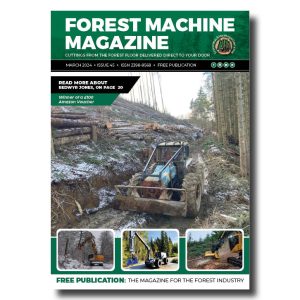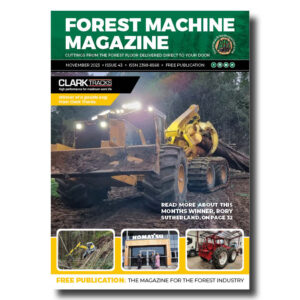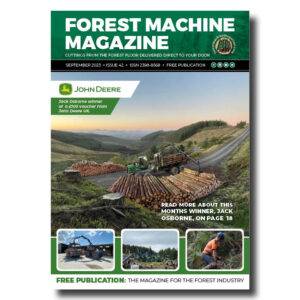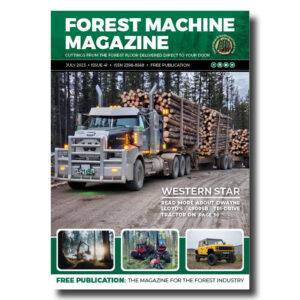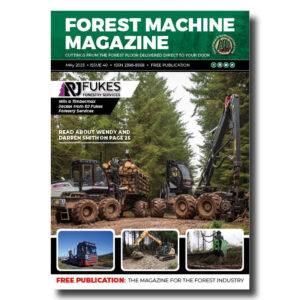The US Lumber Prices Crash is sounding alarm bells on Wall Street
US Lumber Prices Crash- Wood markets have been whipsawed of late by trade uncertainty and a deteriorating housing market. Futures have dropped 24% since hitting a three-year high at the beginning of August and ended Monday at $526.50 per thousand board feet.

-
That’s a remarkable amount of work hours for a single machine, the Norcar 600 owned by Erkki Rinne is taken well care of, it even has the original Diesel engine.
-
Kieran Anders is a forestry contractor working in the lake district. His work involves hand cutting and extracting timber using a skidder and tractor-trailer forwarder.
-
It is not possible to eliminate chain shot, but there are simple steps that can be taken to reduce the risk.
-
Arwel takes great pride in the fact that the mill has no waste whatsoever, “the peelings are used for children’s playgrounds, gardens and for farm animals in barns in the winter and the sawdust has multiple uses in gardens and farms as well.
-
Timber hauliers need to encourage young blood in, and also look after the hauliers we have, we need make the sector a safe and positive place to work.
FIND US ON
Related Posts
The price drop might have been greater but two of North America’s biggest sawyers said last week that they would curtail output, slowing the decline.
Crashing wood prices are troubling because they have been a reliable leading indicator on the direction of the housing market as well as broader economic activity.
During the Covid-19 lockdown, two-by-four prices nearly tripled the prepandemic record, an early sign of the inflation and broken supply chains that would bedevil the economic reopening. When the Federal Reserve began raising interest rates in 2022 to curb inflation, lumber was among the first assets to decline in value. Now, prices are signalling caution again.
A glut of lumber was piled up stateside earlier this year in anticipation of higher duties on Canadian imports and additional tariffs on wood threatened by President Trump.
Lumber prices have been on a roller coaster. They rose in the spring after the White House said it was investigating national security aspects of imported lumber and Trump threatened steep tariffs on all Canadian goods.
They crashed when he backed off Canada. In May, they started surging again as buyers began stocking up ahead of the scheduled hike in existing Canadian lumber duties and Trump’s threatened tariffs.
Stinson Dean, a former lumber trader and co-founder of Indiana truss manufacturer Revol Building Solutions, said buyers were more focused on the import taxes than demand when they bid up prices.
Unsure whether there will be tariffs, Dean decided not to stock up and instead has taken a hand-to-mouth approach to supplying his plant, which prefabricates structural framework.
“I was going to lose money because tariffs happen, or I was going to lose money because there were no tariffs,” he said. “It was 50/50 either way. So, I sat on my hands.”
On-the-spot prices are down too, according to Random Lengths. The trade publication and pricing service’s Framing Lumber Composite Index has declined about 12% since 1 August.
Producers are responding by cutting back.
Interfor, North America’s third-largest lumber producer, said Thursday that it will choke back output by 12% with cuts across its sawmills in the US South, Pacific Northwest, British Columbia and eastern Canada. It will reduce hours and reconfigure shifts as well as lengthen holiday breaks and maintenance shutdowns to reduce production by about 145 million board feet through year-end.
Domtar, another big producer, is taking downtime at its sawmill in Glenwood, Ark., indefinitely idling another in Maniwaki, Quebec, and eliminating a shift at its facility in the province’s Côte-Nord region, a spokesman said.

Analysts and traders say there will have to be further cuts to ease the glut of wood. That might not be a problem, given how higher duties have pushed up Canadian sawmills’ break-even prices while demand wanes.
“We anticipate further closures or curtailments,” said Truist Securities analyst Michael Roxland.
The White House is still contemplating broad tariffs on imported wood in the name of national security, as it has with aluminium, steel and copper products. Any tariffs from Trump would be separate from the existing duties levied on Canadian softwood lumber imports, which fulfill about 24% of US consumption.
Those antidumping and countervailing duties are the result of a decadeslong trade dispute. They rose last month to about 35% for most Canadian producers, from 15%. The heavily litigated rates are reset annually based on Canadian exporters’ sales data from two years prior.
Before the duties rose, Canadian mills that manage inventories for big customers ranging from home centres to wholesalers filled warehouses and distribution centres, said Matt Layman, a market analyst and consultant who publishes Layman’s Lumber Guide. That means they already have plenty of unsold lumber near its final destination.
“Producers were so confident, they overlooked one glaring obvious hurdle while piling up lumber in the US: demand or lack thereof,” he said. “There is easily enough wood on the ground in the US to cover several months of anticipated fall demand.”
Residential building permits dropped in July to a seasonally adjusted annual rate of about 1.4 million units, the fewest since June 2020.
Total U.S. construction spending was down 3.4% in July from the record set in May 2024.
Yet mortgage rates have lately trended lower, and Wall Street is pricing in near certainty that the Fed cuts rates at its meeting later this month, according to CME’s FedWatch Tool.
Cheaper borrowing costs could spur more construction and home buying as well as entice homeowners to borrow against their properties to fund repairs and renovations, which are the single greatest source of lumber demand.
Source-The Wall Street Journal

Sign up for our free monthly newsletter here
Contact forestmachinemagazine@mail.com to get your products and services seen on the world’s largest professional forestry online news network.
#homeoflogging #writtenbyloggersforloggers #loggingallovertheworld
Written by loggers for loggers and dedicated solely to the equipment used in forestry operations.


